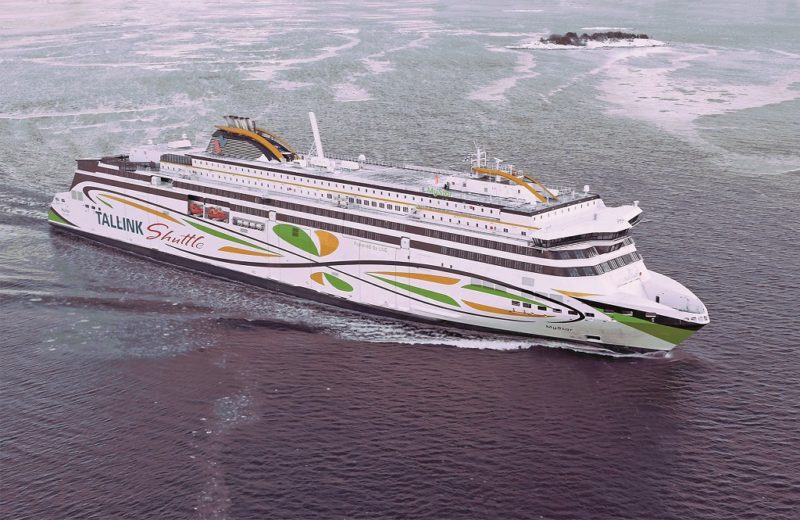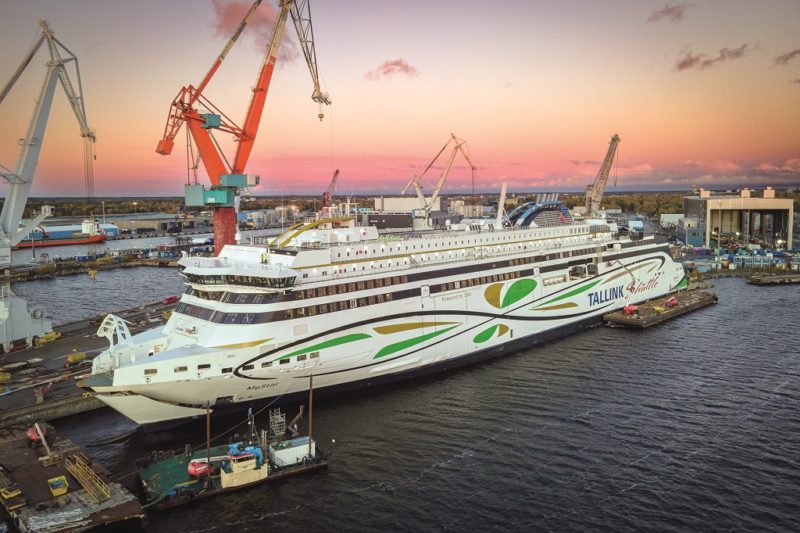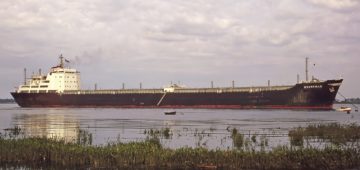On 30th May the 36,249gt/2007-built cruise ferry Oscar Wilde took over the Pembroke-Rosslare service for Irish Ferries, replacing the chartered 29,858gt/2000-built Blue Star 1 of Blue Star Ferries, Greece. The Oscar Wilde was built by Aker Finnyards Helsinki (later STX Finland Oy) as Yard No. 1356, delivered 10th April 2007. She was ordered by the AS Tallink Grupp and entered service as a game-changer on the Tallinn-Helsinki service, introducing the Shuttle Ferry era. The route went from strength to strength and the Star operated with the 36,299gt/2008-built Superstar (now the Pascal Lota of Corsica Ferries) and then the 49,134gt/2017-built Megastar, which replaced the Superstar. On 7th December 2022 a new chapter on the route began when the 50,629gt/2022-built and LNG powered MyStar was delivered to serve alongside the Megastar. The Star was retained for relief/supplementary sailings, but it was clear that she would find a new home sooner rather than later, and she did just that, on the Irish Sea.
The state-of-the-art MyStar, like the Megastar, was built in Finland as Yard No. NB603 at Rauma Marine Construction. This facility was once part of the Aker Finnyards/STX Finland Group. Rauma Marine Construction was founded in 2014 in Rauma after the failure of the STX Finland Group and, at the time of writing, had an order book with a value of €1 billion and 6 vessels under construction. The Tallinn registered MyStar is the subject of this feature and was ordered on 27th March 2019 at a cost of €250 million, the keel laying took place on 18th September 2020 followed by the launch in August 2021 with delivery in December 2022 as mentioned before.
The ferry company Tallink is an Estonian shipping company (part of the Tallink Grupp) and operates cruiseferry services on the Baltic Sea from Estonia to Finland/Sweden and Finland-Sweden. The company is the largest passenger and cargo shipping company in the Baltic region and also owns the Silja Line brand. The company’s history can be traced back to 1965 when the Estonian Shipping Company (ESCO, then a Soviet Union company) introduced a ferry service between Helsinki and Tallinn. Year-round services followed in 1968. In May 1989, ESCO formed Tallink with Palkkiyhtymä Oy. of Finland as a partner. A hydrofoil service was also operated for a time from Tallinn, followed by a catamaran service in 1997. Various secondhand tonnage was employed with the sister ships Romantika (40,803gt/built 2002) and Victoria I (40,975gt/built 2004) being Tallink’s first newbuilds. EstLine’s Tallinn-Stockholm began operating as part of Tallink in 2001 and the HSC Tallink AutoExpress 2 was also acquired that year. In 2002, the then AS Hansatee changed its name to AS Tallink Grupp just before the Romantika was delivered for Helsinki-Tallinn. In 2004, a trio of newbuilds joined the fleet, namely HSC Tallink AutoExpress 3, HSC Tallink AutoExpress 4 and the Victoria I (for Tallinn-Stockholm). In 2005 Tallink ordered the 48,915gt/2006-built Galaxy plus other tonnage before purchasing the Baltic Sea operations of Superfast Ferries from Attica Group in 2006 and later Silja Line. The 36,249gt/2007-built Star then revolutionised the Helsinki-Tallinn service and 48,915gt/2008-built Baltic Princess joined the fleet the following year along with the Superstar from Fincantieri. The AutoExpress 2, AutoExpress 3 and AutoExpress 4 were also withdrawn, ending the company’s fast ferry involvement. The 48,915/2009-built Baltic Queen then joined the ranks for the Tallinn-Mariehamn-Stockholm service. The Superfast vessels were chartered out to Marine Atlantic and Stena Line, never to return. The company has excelled but the pandemic did affect the overall operation if its network. Supplementary income has been secured from chartering out the Star (Irish Ferries) and Romantika (Holland-Norway Lines) along with accommodation work of the fleet.
Spacious Shuttle
The Tallinn-Helsinki Shuttle Ferry service operates 07.30-22.30 with each of the two ships making 3 round trips per day with a crossing time of 2 hours for the 48 nautical mile route. The Megastar has also offered a 22.30 overnight departure from Tallinn that arrives 06.00. The MyStar joined the Megastar on the route when she undertook her maiden voyage on 3rd December 2022 at 13.30 from Tallinn to Helsinki. The ship had been officially christened and launched on 12th August 2021 in Rauma Shipyard, with the Estonian President Kersti Kaljulaid as the ships’ godmother. The MyStar is a near sister of the Meyer Turku-built Megastar, but with refinements made following the former ship’s operation. Interestingly, the Megastar represented a totally new Ro-Pax design for the service, with a double-deck drive-through loading arrangement. The Star was built as a single deck loader but with the ability to be converted, which she was in 2017, as well as an all-MES solution for the evacuation system as the route is exempt from traditional lifeboat requirements. Such a revolutionary option potentially jeopardises the resale value so, very wisely, Tallink future-proofed both the Megastar and MyStar to allow for the later installation of traditional lifeboats. The latter ship also has two Palfinger Marine FRSQ 630G fast rescue boats. The LNG/diesel-electric propulsion introduced with the Megastar has followed on for the MyStar, but the engines this time are 5 identical MAN 8L51/60 DF engines, each with an output of 8,400kW at 500rpm, rather than a 3+2 father and son arrangement in terms of engine size/output.
Transverse bulkheads divide the main engine and generator rooms whilst two Type C LNG tanks (770m3 combined capacity, 30% larger than those installed aboard the Megastar) are located in a single compartment adjacent to the forward generator room. The LNG system was provided by Høglund Marine Solutions and the dual skinned and insulated gas tanks were fabricated by Finnish tank manufacturer West Welding. The dual fuel capability of the Megastar and MyStar has been a huge bonus, as other operators with modern dual fuel tonnage have found, due to the recent increase in LNG wholesale prices. Both ships were switched to marine diesel oil as their primary fuel until prices for LNG became more favourable. The average fuel consumption for the new ship is given as 187.3 g/kWh (1,561 kg/h) with MDO consumption being 154.4g/kWh at 80% MCR and 1,280kg/h at 80% MCR for LNG. ABB was the supplier of the ship’s five 9,098kVA main synchronous generators, the twin 3kV/20,300kW output (at 138rpm) synchronous propulsion motors, the twin 2,200kW stern and twin 2,20kW bow thruster motors for the Kongsberg-built thrust units plus a shore power connection system, allowing the ship to plug into the local grid when alongside in port. Propulsion is via twin 10m diameter/138rpm fixed pitch propellers, the service speed is 27 knots (at 85% MCR) and a Fincantieri stabiliser system is fitted.

Like the Megastar, the MyStar also has a ducktail as part of her hull form, which extends the effective waterline. Such a feature can reduce the power output requirements by up to 10%. As with many of the newbuilds, the MyStar is equipped with the very latest technology options to recover both the waste heat and waste cold from the use of LNG. A waste heat system converts heat from the engines’ exhaust and cooling water into renewable energy for the ship’s central heating system. The waste cold is recycled for use with the refrigeration and HVAC equipment. The 12-deck MyStar has capacity for 2,824 passengers, employs a crew of 248 and offers 46 passenger cabins (170 beds) and 136 crew cabins. The overall lanemetre capacities for the ship are given as 1,297.9lm for cars and 1,983lm for freight. The main vehicle garage is on Deck 3 with a lanemetre capacity of 1,244lm, a 4.60m clear height and a deck load of 2 tonnes/m2. The folding bow ramp is 22.10m overall and extends out from behind a pair of clamshell-style bow doors. The access width to/from Deck 3 at the bow is 6m. The twin stern ramps are longer than usual at 11.75m overall due to the ducktail. The clear width over each stern ramp is 7m and the centre casing is offset to provide an arrangement of 3 freight lanes portside and 5 on the starboard side. The lane widths are 2.90m minimum, the axle load is 2x 15 tonnes and the maximum trailer weight is 45 tonnes. The upper vehicle garage is on Deck 5 with a 6m wide access gate in the bow, likewise a watertight hinged door on the forward superstructure and a 6-lane wide roller curtain to weatherproof the open aft end of the deck. To maintain flexibility, a 45.4m long, two-lane tiltable ramp is installed midships on the starboard side to link with Deck 3. There is a fixed car deck (Deck 6) along the full length of the offset centre casing with access to Deck 5 via hoistable ramps fore and aft. The clear height below the car platform is 2.4m with a 2.1m free height on Deck 6. Deck 5 has a 522lm capacity for cars with Deck 6 offering a further 398lm for cars. The Deck 6 platform is also equipped with dedicated spaces to park motorbikes and charge electric scooters. To the portside on Deck 6 are a pair of 3m wide fixed ramps that lead to Deck 7. The mixed traffic provisions on Deck 5 means that space for freight stands at a total of 739lm along the outer lanes only. The deck load for the car garage areas is 0.3 tonnes/m2 and the clear height on Deck 5 is given as 4.40m beneath the stowed car ramps. The 2.40m clear height/0.3 tonnes/m2 deck load car garage on Deck 7 is closed off from the decks below at sea by top-hinged doors. This garage is both heated and lit with up to 80 cars being parked in large parking bays with passengers able to access their vehicles throughout the voyage as the areas acts like a shopping centre car park, complete with trolley bays and charging points for electric cars. Similar to what was first introduced aboard the Megastar, this car deck occupies 50% of the length of Deck 7.
The layout of the adjoining two-storey 2,747m2 Traveller Superstore on Decks 7/8 is a modified version of that found aboard the Megastar, taking up additional space. The checkouts are on Deck 7 so that purchases can be taken directly to parked vehicles.
The interior design was undertaken by dSign Vertti Kivi & Co. with the concept being called “Beauty of the Baltic Sea,” drawing inspiration from the Baltic Sea, its environment, culture and people. The public areas total 8,742m2, the interior spaces overall cover 9,397m2 and there are 3,069 seats, so plenty for everyone. The sun deck totals an area of 473m2. The MyStar was heralded as a true floating entertainment centre that meets both the current as well as future travellers’ needs. She has even more customer areas, including 7 passenger lounges, 7 restaurants, cafes and bars, and much more. In addition to the ever-popular Comfort and Business lounge, the MyStar features a new and exclusive Platinum Lounge plus a completely new area designated for families with kids called Family Picnic complete with a Lottemaa play area. Travelling pets are also welcome as there is a special kennel onboard. The 232-seater Family Picnic (Deck 8) and Platinum Lounge are included in the “wow elements” woven into the public areas with others including a Selfie-spot and glass balcony on the Sun Deck located on deck 10, Magic Mirrors located in selected toilets on deck 8, the Moomin family display and photo opportunity for kids with Moomins also found inside the Traveller Superstore on deck 7.
There is also an impressive garden area located on deck 9. Deck 8 also features a 482-seat Coffee & Co. Lounge and the hub of the ship, the reception area. Forward on Deck 8 is the 188-seat Comfort Lounge on the portside (supplement payable), offering free refreshments, non-alcoholic beverages, newspapers and Wi-Fi. There is also a small meeting room, adjacent to which is the aforementioned ultra-deluxe six-seater Platinum Lounge next to the 160-seat Business Lounge. One level above, Deck 9 is the restaurant (795m2) and bar deck with the 376-seat Delight Buffet located forward and an 84-seat Chef’s Kitchen à la carte restaurant located to starboard. Aft of the ship’s main galley is the 356-seat Fast Lane self-service restaurant, which adjoins the Burger King fast food outlet on the port side.
Further aft is a quiet, 297-seat reclining seat lounge on the portside, with the Nordic Bar on the starboard side. The aft section of Deck 9 offers the Sea Pub, the ship’s main bar, and the Garden lounge, which resembles a conservatory, complete with outdoor section. Deck 10 is the bridge deck where the cabins are for the officers, crew and passengers. 43 of the 44 passenger cabins are outside, including one suite. This deck also houses the crew pantry and a dedicated 83-seat commercial driver’s restaurant, with adjoining sauna. Deck 11 has more crew cabins (136 in total on both decks) and the emergency bridge control room is situated on Deck 12. The sleek and stylish ship’s profile is complimented by her unique Tallink Shuttle livery.







Comments
Sorry, comments are closed for this item